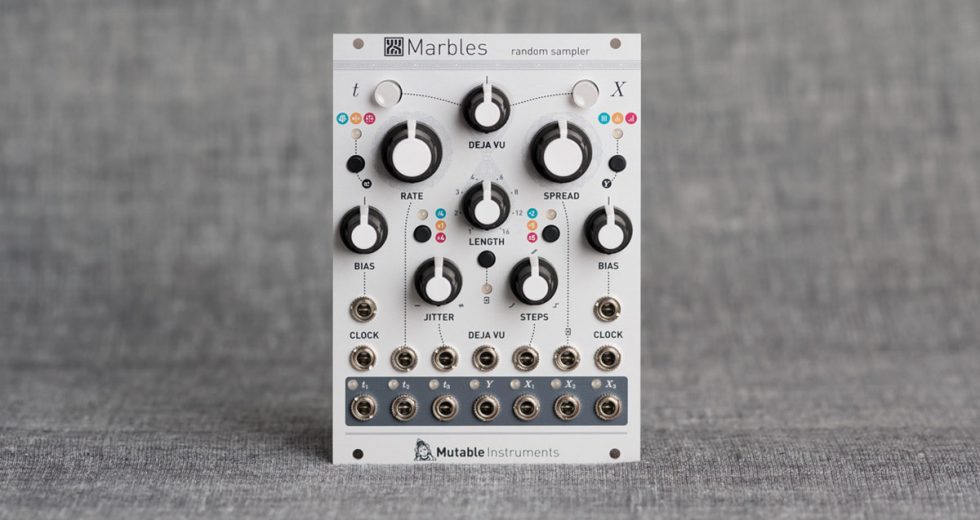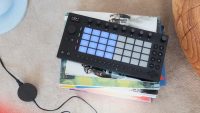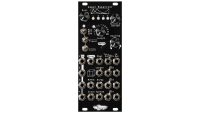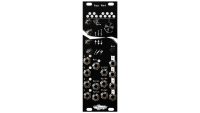Random sampler
Controlled chaos, repeatable randomness
Marbles is a source of random gates and voltages, which offers an extensive amount of (voltage) control on all the different flavors of randomness it produces.
The module gives the musician many different ways of imposing structure on the random events generated by the module: synchronization to external clocks, control of the repetition or novelty of the generated material, quantization of the voltages, or randomization of gates or voltages generated by traditional sequencers.
t: the random gate generator
Marbles either follows its own internal clock, or locks onto an adjustable multiplication/division of an external clock (or regular rhythmic pattern). This regular clock is perturbed by a process simulating an instrumentist playing along a click and trying to catch up on their errors – from perfect accuracy to complete chaos.
From this imperfect master clock, a 2-channel random rhythm is generated, using one of the following processes: random coin toss (similar to Branches), random ratcheting, or random drum pattern generation (similar to a randomly modulated Grids).
X: the random voltage generator
This generator produces 3 channels of random voltages, each of them clocked by the individual outputs of the t section, or by a common external clock signal.
Complete control on the distribution of the output voltages is provided: concentrated or spread-out, quantized or unquantized, smoothed or steppy, centered or biased towards a specific voltage. The same transformations can be performed on an external CV, for sample-and-hold or shift-register operation.
An auxiliary slowly fluctuating random voltage output (Y) is also available for self-patching fun!
A feeling of déjà-vu…
Marbles remembers the history of every recent clock deviation, rhythm or voltage it has generated. The DEJA VU knob on the panel controls the probability of reusing past material instead of sampling fresh random data.
You are thus given control on the feeling of repetition and structure in the generated random voltages and rhythms. At the extreme, the module no longer generates any novel values and loops over the same pattern (or a random permutation of it). And of course, this (variably) random looping can be performed on external CVs!
Random gate generator
Master clock
- Internal clock with adjustable rate (with V/O CV input), or division/multiplication of an external clock.
- Range selection button further multiplying or dividing the clock by 4.
- Rhythm follower/predictor to lock onto uneven clock divisions or rhythmic patterns.
- Adjustable jitter (knob and CV), going from perfect tracking to completely erroneous – but always preserving the overall tempo.
Two-channel random rhythm generator
- Three gate outputs: t2 is the main output carrying the jittery clock, t1 and t3 are the complementary random rhythm output.
- Three generative models, with CV-controlled bias parameter increasing the density of notes on one channel or the other:
- Random routing of each clock pulse to either outputs, following a coin toss.
- Selection of a random division factor for one output, and the reciprocal factor for the other.
- Generation of random kick/snare patterns using a process similar to Grids.
- Adjustable gate duration, from short triggers to full length. Gate duration can be randomized.
Random voltage generator
- 3 outputs, either clocked by the 3 outputs of the random gate generator, or by a common external clock.
- Distribution control: SPREAD control, scanning between constant, bell-shaped, uniform or discrete distributions; and BIAS control biasing the generated voltage towards the bottom or top of the voltage range.
- Adjustable range: 0 to +2V (for melodies), 0 to +5V, -5V to +5V.
Quantized or smooth… CV Post-processor
- The STEPS parameter controls the steppiness/quantization of the output voltages.
- Turn this knob clockwise and a progressive quantizer is applied to the voltages – progressively reducing the probability of hitting a note outside of the scale, then making accidentals less likely, then giving more weight to the root and fifth – and at the extreme yielding only octaves.
- If steppy is not your thing, turn counterclockwise to increasingly slew the output voltages to the point that the module produces smooth, continuous curves.
Programmable quantizer
- 6 programmable scales.
- Scales are programmed by playing a short jam in the target scale: Marbles learns which notes are more prominent than others.
Output diversity
- The three outputs can all follow the settings dialed on the control panel, or react in different and opposite ways. The turn of a knob can completely push your patch towards a new direction!
Random looping and shuffling
- DEJA VU parameter increasing the probably of re-playing past material to the point that the generated output forms a loop… then increasing the probability of randomizing the order of this loop.
- The DEJA VU control applies to the random rhythm, the random voltages, or to both, or neither of them.
- Adjustable loop length from 1 to 16 steps.
External CV processing
- An external CV can be recorded in the DEJA VU loop in place of internal random voltages.
- All transformations performed by the random voltage generator (looping, shuffling, spreading, transposition, quantization, lag-processing) can be performed on external voltages.
- TLDR: live remixing of external sequences!
Specifications
- Analog random source.
- All inputs: 100k impedance, DC to 3.2kHz.
- Maximum input clock rate: 1kHz for the t Section, 8kHz for the X section.
- 32kHz refresh rate.
- 14-bit DAC with accurate software calibration – error below 1mV.
- 12-bit CV capture.
- Output levels: -5V to +5V for CVs (largest setting), 0V to +8V for gates.
- Input CV range: -5V to +5V.
- Front panel with Computer Modern labels, just like on your calculus textbook.
IDR 5.385.000





